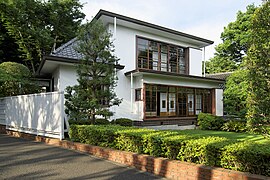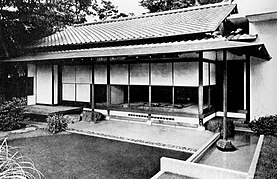Horiguchi Sutemi
Horiguchi Sutemi ( Japanese 堀 口 捨 巳 ; born January 6, 1895 in Gifu Prefecture ; died August 18, 1984 ) was a Japanese architect of the Taishō and Shōwa periods .
life and work
Horiguchi Sutemi graduated from the Department of Architecture at the University of Tokyo in 1920 and teamed up with old school friends to replace the eclectic styles of the time with an architecture that was scientifically and theoretically founded. With this in mind, he designed various buildings for the 1922 Peace Memorial Exhibition, where the influence of the Vienna Secession can be felt.
In 1923 Horiguchi traveled through Europe, where he studied the latest work of the Bauhaus . Back in Japan, he advocated functionalism in architecture, as demonstrated by his villas for the Yoshida family (1930), Wakasa family (1939) and the Ōshima meteorological station (1939). At the same time, he immersed himself in the study of traditional Japanese architecture, trying not to leave the Japanese tradition to the ultra-nationalists. He realized that the interior design of a tea house and residences in the Sukiya style was basically the same as that used for their buildings in western countries.
Horiguchi implemented his findings in his plans for residential houses: They are characterized by a close relationship between the building and the surrounding garden. His most important work from the early period is the (no longer existing) Villa Shien-sō (紫烟 荘) in Warabi from 1926.
After the Pacific War , he designed the suite "Miyuki no ma" (御 幸 の 間) in the Hasshō-kan (八 勝 館), a property in the southeast , in 1950 for the first visit of the Emperor Shōwa with the Empress in Nagoya, combined with an overnight stay the city. Gold leaf on the side walls, on the ceiling and on the balcony give the room its elegance. In 1958 the facility was expanded to include the "Cherry Blossom Suite" and the "Chrysanthemum Suite". On the occasion, an air conditioning system was installed, whereby great importance was attached to integrating it inconspicuously into the traditional architecture. - One of the late buildings was the expansion of part of Meiji University , where he was a professor from 1949 to 1965.
Horiguchi wrote a number of books on architecture. For his band "The Katsura Villa" (桂 離宮, Katsura rikyū) he received the Mainichi Culture Prize in 1953 .
photos
Meiji University Izumi Sports Hall (1955)
Remarks
- ↑ The Peace Pagoda (平和 塔, Heiwa-tô) was built on the occasion of the Tōkyō (平和 記念 東京 博 覧 会, Heiwa-kinenTōkyō hakurankai) memorial exhibition.
Individual evidence
- ↑ Ōshima Sokkōjo (大 島 測 候 所).
- ↑ Japan Architect (ed.): Hasshokan 1950/1958. In: A Guide to Japanese Architecture. Shinkenchiku-sha, 1975. p. 133.
literature
- Tazawa, Yutaka: Horiguchi Sutemi . In: Biographical Dictionary of Japanese Art. Kodansha International, 1981. ISBN 0-87011-488-3 .
Web links
| personal data | |
|---|---|
| SURNAME | Horiguchi, Sutemi |
| ALTERNATIVE NAMES | 堀 口 捨 巳 (Japanese) |
| BRIEF DESCRIPTION | Japanese architect |
| DATE OF BIRTH | January 6, 1895 |
| PLACE OF BIRTH | Gifu Prefecture |
| DATE OF DEATH | August 18, 1984 |




